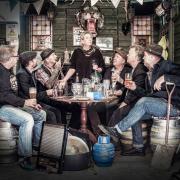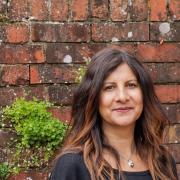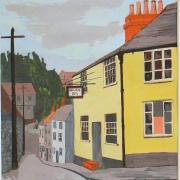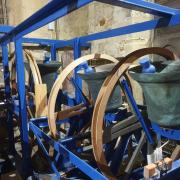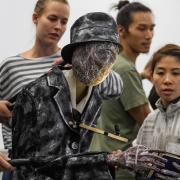P J Harvey MBE: This twice Mercury Prize winning singer, songwriter and musician. is a true daughter of Dorset. Polly Jean Harvey was born on October 9,1969 in Bridport. Her music-loving parents owned a quarrying business, and Harvey grew up on the family farm in Corscombe. She went to Beaminster School where she had guitar lessons from folk singer-songwriter Steve Knightley (Show of Hands). Music must run through her family as her cousin is the boogie-woogie pianist Ben Waters.
Harvey’s first Mercury Prize was in 2001 for Stories from the City, Stories from the Sea, her second in 2011 was for Let England Shake, which was recorded at St Peter’s Church in Eype near Bridport. To date, PJ Harvey is the only artist to ever win the Mercury Prize twice. pjharvey.net

Mary Anning (1799 –1847): This trailblazing fossil collector and palaeontologist did not always receive full credit for her scientific contributions, and yet this Dorset woman contributed to changes in scientific thinking about the origins of prehistoric life. Scouring the cliffs and beaches near her home in Lyme Regis, especially after winter storms, she identified her first ichthyosaur skeleton when she was only 12. Selling her numerous finds to museums and collectors around the world not only helped to bring in an income but her extensive knowledge of fossils made her well-known in scientific circles way beyond Dorset.
Lyme Regis is very proud of Mary Anning, there is a gallery named after her at Lyme Regis Museum where you can find out about some of her local fossil discoveries. The town was also used as a location for the film Ammonite (2020) starring Kate Winslet as Anning. In 2018, a campaign called ‘Mary Anning Rocks’ was started by local school girl, Evie Swire. The aim was to raise enough money to erect a statue of Mary in her home town. Garnering support from the likes of Professor Alice Roberts, Sir David Attenborough and novelist Tracy Chevalier (who wrote the book Remarkable Creatures about Anning), sculptor, Denise Sutton, has created a statue of Anning and her dog which is due to be unveiled on 21 May 2022, the 223rd anniversary of Anning's birth. maryanningrocks.co.uk

Jane Digby (1807 – 1881): Famous for her many marriages and scandalous love affairs, Jane Elizabeth Digby’s life was never boring. Born in Holkham Hall, Norfolk, she was daughter of Admiral Henry Digby and Lady Jane Elizabeth Coke. In 1815 her father inherited Minterne House in Dorset from her maternal grandfather, Thomas Coke, so the family moved to the county.
During her lifetime Jane clocked up four husbands and many lovers, including several kings, princes, counts and lords, but it was in later life that she found true happiness. At age 46, Digby travelled to Syria and fell in love with Sheik Medjuel el Mezrab who was 20 years her junior. They were married under Muslim law, she became Jane Elizabeth Digby el Mezrab, and they enjoyed 28 happy years until her death at the age of 74.
For an English aristocrat to embrace this way of life is extraordinary, but the fact that this was a woman in the mid-19th century makes it truly remarkable. Jane adopted Arab dress, spoke and wrote in Arabic, as well as eight other languages, and spent half the year living in a goat-hair tent in the desert with her husband’s tribe and the other half in a palatial villa in Damascus. If you want to read more about this remarkable woman from Dorset, then get hold of Mary S. Lovell’s book, A Scandalous Life. The grounds of Minterne House, famous for their collection of rhododendrons and azaleas from the Himalayas, are open to the public. minterne.co.uk

Dame Elisabeth Jean Frink (1930 – 1993): Though born in Suffolk, the renowned sculptor and printmaker had a deep love of Dorset, the county that she called home for the last 16 years of her life. Her obituary in The Times noted the three essential themes in Frink’s work as "the nature of Man; the 'horseness' of horses; and the divine in human form."

Frink is probably best known for her bronze outdoor sculpture, and some of her work can be seen at Dorset Museum in Dorchester. The Elisabeth Frink works, donated by the artist's family, were created at her former home in Woolland, near Blandford and include 30 sculptures as well as over 100 prints and drawings spanning 40 years of Frink’s career. My favourite is ‘Dog’ 1958. You can also see her work in the county town - The Dorset Martyrs Memorial - three standing figures - by Frink was unveiled in 1986 on the site of the gallows (corner of Icen Way and South Walks) where Catholic martyrs were hanged in the 16th and 17th centuries. dorsetmuseum.org

Lady Mary Bankes (1598 – 1661): Lady Mary was the lady of the Corfe Castle and, along with her husband Sir John Bankes who was Attorney-General of King Charles I, a staunch Royalist. When civil war broke out in 1643, her husband went off to fight, and the mother of ten assumed control of Corfe Castle where she remained with her children, servants, and a force of five men.

Corfe Castle was the last Royalist garrison on the Dorset coast and before long the castle was under siege from Parliamentarian forces. Over the next three years Mary and her plucky band managed to repel several attempts to take the castle. During one incident they dispatched stones and hot embers from the battlements. But in 1646, she was betrayed and Parliamentary soldiers managed to gain access to the castle. Lady Mary was forced to surrender, though she was allowed to keep the keys to the castle as a gesture of respect for her courage for holding out against the Parliamentary forces. These keys are now held at Kingston Lacy which became the new family seat. Now looked after by the National Trust there is a very fine statue of Lady Mary holding the keys to Corfe Castle by Baron Carlo Marochetti on the first turn of the marble staircase. nationaltrust.org.uk/kingston-lacy
Click here for Dorset afternoon tea places for a Mother's Day treat









